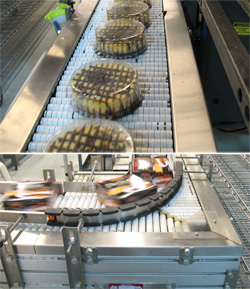TECH FLASH
Rollers take the pressure out of conveying

|
| Advanced roller conveyors protect cheesecakes in a production line. (top): A plastic dome is placed over the top of the cake to keep the toppings intact before shrink-wrapping. (bottom): The Slip-Torque low back-pressure accumulation system stages the cheesecake cartons for induction into the case packer. Source: Shuttleworth. |
When most food manufacturers think about conveyors designed for food packaging lines, they primarily think about meeting requirements for cleanliness and sanitation. But whether to go with a wipe-down or heavy washdown conveyor system is just the beginning. Today, food manufacturers are just as concerned about the latest technology in smart automation and devices that can streamline any food packaging line into extreme efficiency.
Conveyors for food packaging can be equipped with smart, advanced roller systems, which minimize product damage by utilizing a low back-pressure accumulation system, according to Steve Beavans, Shuttleworth LLC application engineering manager. This technology provides low line-pressure throughout a continuous-motion accumulation conveyor that allows for precise product placement on the conveyor while it continues to take product flow from an upstream line for a period of time. A low-pressure accumulation buffer absorbs irregularities in the production flow and provides a smooth, even flow on the line, says Beavans.
This roller-system technology uses individually powered, stationary rotating roller shafts covered with loose, segmented rollers, which become the conveyor surface. It is powered by a continuous chain to control the drive force of the conveyed product. When the food products stop on the surface of the conveyor, the segmented rollers beneath them also stop, generating low back-pressure accumulation, minimizing product damage, according to Beavans.
It is the weight of the product being conveyed, combined with the coefficient of friction between the shafts and the inside diameter of the rollers, that provides the driving force. As the weight of the product increases, there is a corresponding increase in the driving force supplied, says Beavans.
The same conveyor can be split into multiple, independently operating lanes if desired. For example, the middle lane can accumulate, while at the same time, the right lane and the left lane can both convey, or even run in opposite directions. Each lane can act independently, but is powered by only one common motor, which also reduces energy costs, claims Beavans.
These conveyors have the ability to modulate the speed of different sections of the conveyor via a central control PLC and HMI. As food products are moving down the line, the rollers at the back end of the conveyor can be moving faster than the ones at the front end of it. The products can be moving at variable speeds on different sections of the conveyor as dictated by throughput requirements. This controls the food product spacing on the conveyor, keeping items such as delicate cheesecakes separated and equally spaced from each other to minimize product contact and facilitate infeed into packaging equipment such as shrink wrappers, explains Beavans.
Motorized rollers can also be used to minimize product contact while steering products into desired locations, such as employing rollers with herringbone patterns to orient food products without the use of guardrails, or setting up a series of sequentially smaller roller heights to direct food products into the center of the conveyor for packaging induction, without touching any other conveyor parts. This technology can be used in elevated-temperature applications such as hot products coming out of ovens up to 500° F (260°C) and in low-temperature applications down to -20° F (-29°C) for ice cream and other frozen foods, according to Beavans.
Many conveyors for the food industry use product stops, pushers and clamps that can be used to modify the flow of food items. But side-mounted devices are limited in their flexibility to control product flow because of their side-only mounting locations, and top-mounted devices are usually considered less desirable by manufacturers because of safety and product contamination concerns, claims Beavans.
“More advanced conveyor designs for food handling use the space between rollers to allow these devices to be mounted below the surface, reaching up between the rollers to effect more precise and flexible product motion control without interfering with the line flow,” adds Beavans.
“Motion control devices can be more specifically located on food product conveyors compared to conventional systems, bringing a much higher level of positioning accuracy (and more positive product handling for fewer product defects) to the food packaging conveyor process,” says Bevans. Devices like blade stops and brakes that enable on-demand stops and starts of production flow and lift-and-transfer, lift-and-rotate, side-transfer and turntable devices are used to provide a smooth, accurate product transfer at a 90° angle to the original transport direction or to change the orientation of products on the conveyor. Product positioners accurately position products for a particular process; pushers push products perpendicularly from one conveyor traffic lane to another traveling in the same or the opposite direction, into or out of operator workstations or off of the conveyor system completely; and single-row combiners efficiently combine food products in multiple lanes into a single row, according to Beavans.
For more information: Steve Beavans, 260-359-7889, via email.
Looking for a reprint of this article?
From high-res PDFs to custom plaques, order your copy today!




